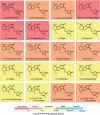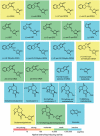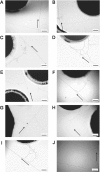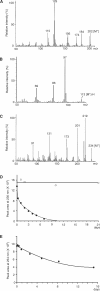Structural requirements of strigolactones for hyphal branching in AM fungi
- PMID: 20418334
- PMCID: PMC2900820
- DOI: 10.1093/pcp/pcq058
Structural requirements of strigolactones for hyphal branching in AM fungi
Abstract
Strigolactones are a group of terpenoid lactones that act as a host-derived signal in the rhizosphere communication of plants with arbuscular mycorrhizal (AM) fungi and root parasitic weeds as well as an endogenous plant hormone regulating shoot branching in plants. Strigolactones induce hyphal branching in AM fungi at very low concentrations, suggesting a highly sensitive perception system for strigolactones present in AM fungi. However, little is known about the structural requirements of strigolactones for hyphal branching in AM fungi. Here, we tested a series of natural and synthetically modified strigolactones as well as non-strigolactone-type germination stimulants for hyphal branching-inducing activity in germinating spores of the AM fungus Gigaspora margarita. All tested compounds with a tricyclic lactone coupled to a methylbutenolide via an enol ether bond showed activity, but differed in the active concentration and in the branching pattern of hyphae. Truncation of the A- and AB-rings in the tricyclic ABC lactone of strigolactones resulted in a drastic reduction in hyphal branching activity. Although the connection of the C-ring in the tricyclic lactone to the methylbutenolide D-ring was shown to be essential for hyphal branching, the bridge structure in the C-D part was found not necessarily to be enol ether, being replaceable with either alkoxy or imino ethers. These structural requirements in AM fungi are very similar but not identical to those observed in root parasitic weeds, especially with respect to the enol ether bridge in the C-D part.
Figures




References
-
- Akiyama K., Matsuzaki K., Hayashi H. Plant sesquiterpenes induce hyphal branching in arbuscular mycorrhizal fungi. Nature. 2005;435:824–827. - PubMed
-
- Arite T., Umehara M., Ishikawa S., Hanada A., Maekawa M., Yamaguchi S., et al. D14, a strigolactone-insensitive mutant of rice, shows an accelerated outgrowth of tillers. Plant Cell Physiol. 2009;50:1416–1424. - PubMed
Publication types
MeSH terms
Substances
LinkOut - more resources
Full Text Sources
Other Literature Sources

